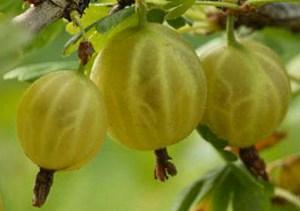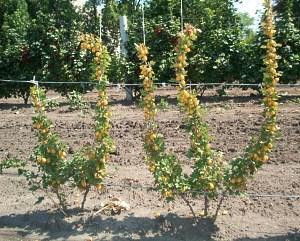Tips on how to properly plant gooseberries
 It is rare to find a garden plot or fruit and berry plantation without gooseberries growing on them. It is also called "northern grapes" for its pleasant delicate taste and for the ability to grow in rather harsh weather conditions.
It is rare to find a garden plot or fruit and berry plantation without gooseberries growing on them. It is also called "northern grapes" for its pleasant delicate taste and for the ability to grow in rather harsh weather conditions.
Round or oval gooseberries contain sugars, vitamins and acids, so its berries must be introduced into the diet of the whole family, especially since a variety of varieties will allow you to easily choose 2-3 bushes for planting.
The selection of a variety of early, late and medium ripening will allow you to feast on fresh berries for a month, and canned or frozen fruits will replenish the supply of vitamins and cheer up in the winter season. Compotes, jelly, marmalade, jam and wine are prepared from sweet and sour berries.
Conditions for planting gooseberries

This crop is self-fertile; the presence of bushes or pollinating varieties is not necessary for it. But if you wish, you can plant nearby thornless or thorny bushes with yellow, red, dark purple berries of a sweet or sweet-sour taste. You can give preference to bushes not spreading, but a standard form.
When choosing a place for planting, take into account the love of light and the long lifespan of the gooseberry - abundant fruiting up to 15 years and a gradual decrease in yield, sometimes up to 40 years of life.
Therefore, planting gooseberries should be carried out where you do not plan any buildings in the coming years, so that the bushes grow in a sunny area without shading.
Soil for gooseberries can be almost any: clay and sandy, loamy and sandy loam. The only thing is that he does not like boggy and acidic soils.
Any land can be adjusted to the requirements of the gooseberry. So, in the sandy and sandy loam it is necessary to bring organic matter every year, and very often loosen the clayey so that the air they need reaches the roots. Perfectly even fruiting and gooseberry growth is observed when plants are planted in light dry areas. Weeds around the bushes should be removed regularly.
 In order to start harvesting a bountiful harvest of sweet aromatic berries in a few years, you need to correctly determine the place where to plant the gooseberries. Set aside a sunny, level, wind-protected area for planting it. Groundwater should lie no higher than 1 m from the surface of the earth, because the roots of the gooseberry grow to a depth of 50-70 cm; otherwise, they may rot, the plant will begin to ache.
In order to start harvesting a bountiful harvest of sweet aromatic berries in a few years, you need to correctly determine the place where to plant the gooseberries. Set aside a sunny, level, wind-protected area for planting it. Groundwater should lie no higher than 1 m from the surface of the earth, because the roots of the gooseberry grow to a depth of 50-70 cm; otherwise, they may rot, the plant will begin to ache.
The peculiarities of planting gooseberries in the Moscow region are no different from planting in the Volga region or Siberia. Here are just varieties you need to choose zoned, suitable for growing in this region.
So, for the Moscow region, the varieties English yellow and Warsaw are suitable, and for the Volga region - African, Grace, Kolobok.
Gooseberry planting rules
 Following the rules for planting gooseberries in a permanent place on the site, as well as other perennial plants, you first need to decide when it is best to do this. Plants are usually planted either in early spring, before bud break, or in autumn after the end of the growing season. Exceptions are seedlings with a closed root system, the timing of their planting can be shifted, but not much, and not for the hottest and driest time.
Following the rules for planting gooseberries in a permanent place on the site, as well as other perennial plants, you first need to decide when it is best to do this. Plants are usually planted either in early spring, before bud break, or in autumn after the end of the growing season. Exceptions are seedlings with a closed root system, the timing of their planting can be shifted, but not much, and not for the hottest and driest time.
Gooseberries are preferably planted in the fall, from mid-September to early October. When planting gooseberries in the fall, it will have time to take root well before the onset of frost, will go into winter, and in the spring with good roots it will begin to grow successfully.
The survival rate of seedlings during spring planting is somewhat worse.
How to plant gooseberries in the fall?
So, you purchased a seedling in a fruit nursery or from your hands, and perhaps you yourself have grown it.
Follow these tips when planting gooseberries so that the plant doesn't disappoint you in the future:
- Prepare places for future planting at a distance of about 1.5x1.5 m, taking into account the dimensional characteristics of a bush of a particular variety. Dig up and clear the area around them of weeds, it is best to start doing this at least a couple of weeks before planting in order to remove the grass for sure, preferably with roots.
- Dig holes measuring 40 * 50 * 50 cm.If you have quite a lot organic fertilizers - humus, manure, compost, - then add them not only to the pits, but also scatter them around them at the rate of 3-4 kg / 1 sq. m. But if the amount of organic matter is limited, then pour it only under the bushes themselves, in the pits, mixing with fertilizers - superphosphate and potassium chloride, as well ash and dolomite flour. Since you decided to plant gooseberries in the fall, no urea or other nitrogen fertilizers are needed at this time of year! They will only come in handy next spring.
- Inspect the seedlings, remove the broken branches, cut off the damaged roots. Carefully spread the roots of the seedling in the hole in depth and to the sides, deepening it by 4-6 cm from the previous planting height. Cover the roots with earth and tap lightly to compact it around the roots. Pour at least a bucket of water under each bush and mulch with humus or peat.
- Cut the shoots of the newly planted plant to small stumps with 3-5 growth buds. Of these, the first main branches will begin to grow in the spring.
The subsequent care of the gooseberry bushes will be simple. As the seedling grows, it will need props to prevent long shoots from falling on the ground.
 Watering is carried out as needed: the bush cannot be poured, but in hot dry times, especially during the period of pouring berries, it is necessary to water.
Watering is carried out as needed: the bush cannot be poured, but in hot dry times, especially during the period of pouring berries, it is necessary to water.
Loosening is carried out periodically, especially after heavy rains, in order to avoid crusting on the ground under the bush. When loosening, do not forget to remove all weeds, possibly by roots.
Digging is permissible only to a depth of no more than 5-8 cm, since the roots of the gooseberry are close to the surface of the earth.
It is possible to fertilize plants during the period of ovary formation and filling of berries with liquid organic matter, as well as in spring - with nitrogen, in autumn - with potash fertilizers.
Thinning and, if necessary, sanitary pruning of shoots is carried out annually, leaving 8-10 strong healthy branches of different ages on the bush.